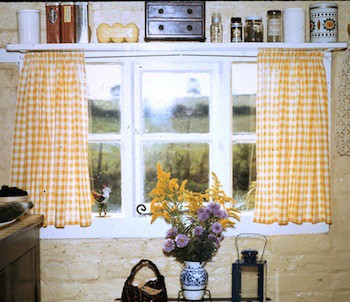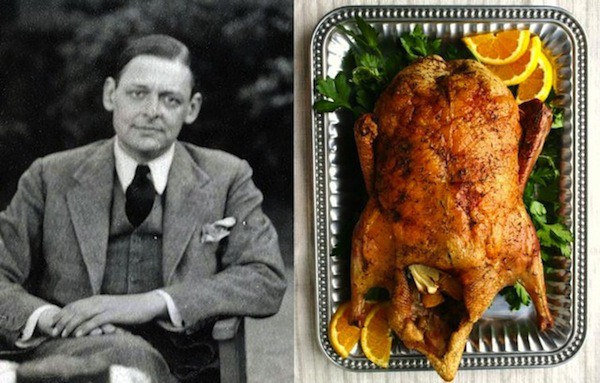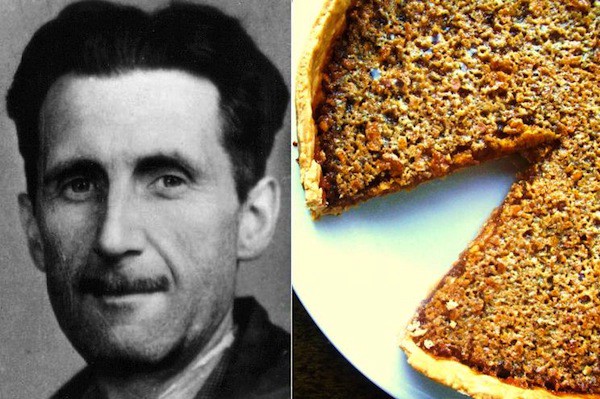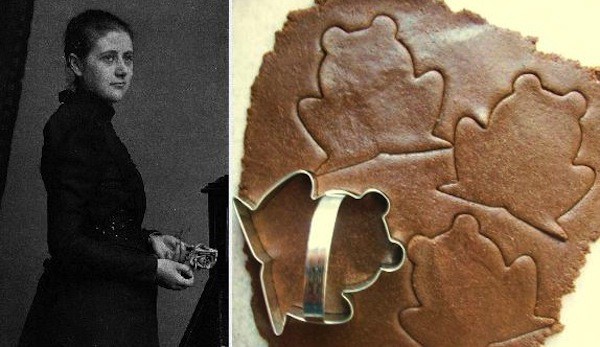How to Cook Like a Writer for the Holidays
by Jen Doll

Scouring the internet, university libraries, and other sources, Nicole Villeneuve digs up the recipes of famous authors — from Alice Munro to Henry Wadsworth Longfellow — and re-creates, photographs, and writes about them on her two-year-old blog Paper and Salt. “The intersection between food and writing has always interested me,” she told me; the blog got its start after she read Hemingway’s collected letters. “He talks about gathering strawberries for making shortcake when he was six, rolling out the shortbread dough with his mom. That first kitchen memory is something that everyone remembers, and I thought, that’s so humanizing.”
Are great writers also more eloquent with regard to what they eat? Or is the act of reading and cooking authors’ recipes just a chance to be closer to the greats, somehow? “I think it’s both,” she said. “Everyone eats, and that’s a great unifier; with food you have the power to express that commonality in a different way, like with Proust and his madeleines. I wanted to bring the books and authors to life in a different way, to feel like I was closer to these writers than I could be simply from reading their work.”
There’s also a fascinating historical component: For instance, “Virginia Woolf didn’t use instant yeast.” Villeneuve updates recipes when she has to — “I don’t want to cook with a pot of lard,” she explains — walking the line between the authentic, original recipe and one that people can still make today.
Cooking is a way to tell a story, and Villeneuve sees the project as a way to engage with books and authors from the past and present. “A lot of women authors liked to bake,” she says. “Emily Dickinson, Virginia Woolf, Alice Munro, they’re all bakers. Sylvia Plath had a lot of cake recipes; Elizabeth Bishop had a brownie recipe. There are also a lot more recipes than I thought there would be from men; that was encouraging. Kerouac had this apple pie fanaticism. Roald Dahl, you just know he’s going to love chocolate.” She remains on the lookout for one dream recipe: “If anyone has this copy of Vegetarian Times from 1997, Ray Bradbury has a recipe in there for something called pizza soup. It sounds just insane.”
Below, she shares a few holiday recipes and anecdotes that you can use to impress the literati at your dinner table.
“Despite being infamously reclusive, Salinger so loved the Saturday suppers at the First Congregational Church in Hartland, Vermont, that he’d arrive early for some slices of their famous roast beef.” (Recipe adapted from Donna Hay)
4 pounds boneless beef rib-eye, tenderloin, or eye round 2 teaspoons mustard seeds 1 teaspoon sea salt flakes 1 teaspoon cracked black pepper 1 tablespoon dried thyme 1 teaspoon dried tarragon 1/4 cup olive oil, plus 1 tablespoon 1 tablespoon Dijon mustard
1. Preheat oven to 250°F. Remove beef from fridge and set aside. Place mustard seeds, salt, pepper, thyme and tarragon in a mortar and pestle and pound until lightly crushed. Add 1/4 cup oil and the mustard and pound until combined. Set aside.
2. Brush beef with remaining 1 tablespoon oil. Heat a large nonstick frying pan over high heat and sear beef 1 to 2 minutes on each side or until brown. Remove from pan.
3. Secure beef with kitchen string and rub with mustard mixture. Place on rack in a roasting pan and cook 1 1/2 hours for medium-rare, or until internal temperature reaches 125°F.
4. After roasting, cover the meat with foil and allow meat to rest in a warm place for at least 10 minutes. Slice thinly and serve.

T.S. Eliot’s Duck à l’Orange
“Tom and Vivien Eliot both cooked extensively at home, throwing frequent dinner parties in their small dining room-slash-library. But the meal that Eliot would always remember wasn’t one he made. It was a dish served at a dinner in 1926 throw by the French journal Action française. It was ‘the most exquisite dinner I have ever tasted — everything done in the best French taste,’ Eliot wrote. ‘I remember the canard aux oranges with permanent pleasure.’ This recipe recreates that classic dish, from a recipe first published in Gourmet a few years later, in 1943.”
1 tablespoon kosher salt
1 teaspoon ground coriander
1/2 teaspoon ground cumin
1 teaspoon black pepper
1 (5- to 6-lb) whole duck
1 orange, halved
4 fresh thyme sprigs
2 fresh flat-leaf parsley sprigs
1 small onion, cut into 8 wedges
1/2 cup dry white wine
1/2 cup duck or veal stock
1/2 carrot
1/2 celery rib
Sauce:
1/3 cup sugar
1/3 cup fresh orange juice (from 1 to 2 oranges)
2 tablespoons sherry vinegar
2 to 4 tablespoons duck or veal stock
1 tablespoon unsalted butter, softened
1 tablespoon fresh orange zest
1. Place oven rack in middle position and preheat oven to 475°F. Stir together salt, coriander, cumin, and pepper. Pat duck dry and sprinkle inside and out with spice mixture. Cut 1 half of orange into quarters and put in duck cavity with thyme, parsley and 4 onion wedges. Spread remaining 4 onion wedges in roasting pan with carrot and celery, then place duck on top of vegetables and roast 30 minutes.
2. In a small bowl, squeeze juice from remaining half of orange and stir together with wine and stock. Pour wine mixture into roasting pan and reduce oven temperature to 350°F. Continue to roast duck until thermometer inserted into a thigh (close to but not touching bone) registers 170°F, 1 to 1 1/4 hours more.
3. Turn on broiler and broil duck 3 to 4 inches from heat until top is golden brown, about 3 minutes. Tilt duck to drain juices from cavity into pan and transfer duck to a cutting board, reserving juices in pan. Let duck stand 15 minutes.
4. While duck roasts, cook sugar in a dry 1-quart heavy saucepan over moderate heat, undisturbed, until it begins to melt. Continue to cook, stirring occasionally with a fork, until sugar melts into a deep golden caramel. Add orange juice, vinegar, and salt (mixture will bubble and steam vigorously) and simmer over low heat, stirring occasionally, until caramel is dissolved. Remove syrup from heat.
5. Discard vegetables from roasting pan and pour pan juices through a fine-mesh sieve into a 1-quart glass measure or bowl, then skim off and discard fat. Add enough stock to pan juices to total 1 cup liquid.
6. Bring pan juices to a simmer in a 1- to 2-quart heavy saucepan, then add the butter mixture, whisking constantly to prevent lumps. Add orange syrup and zest and simmer, whisking occasionally, until sauce is thickened slightly and zest is tender, about 5 minutes. Serve with duck.
Willa Cather’s Marble Pound Cake
“’We had three kitchen tables: one for kneading bread, another for making cakes and pastry, and a third with a zinc top, for dismembering fowls and rabbits,’ Cather wrote. This nineteenth-century recipe, adapted for the modern day, comes from the Board of the Willa Cather Foundation, many of whose members still live near the Cather home in Nebraska.’” (Adapted from At Willa Cather’s Tables)
2 cups sifted all-purpose flour
1 tablespoon baking powder
1/2 teaspoon salt
1/2 cup butter
1 cup sugar
2 eggs
3/4 cup whole milk
1 teaspoon vanilla extract
1 teaspoon cinnamon
1/2 teaspoon ground cloves
2 teaspoons cocoa powder
1. Preheat oven to 350°F and grease a 9×5-inch loaf pan. In a small bowl, sift together first three ingredients. Set aside.
2. In a medium bowl, cream butter and sugar together. Add eggs and stir until combined. Alternatingly add dry ingredients and milk to the butter mixture, starting and ending with the dry ingredients.
3. Divide batter into two halves. Add cinnamon, cloves and cocoa powder to one half of the batter, until fully incorporated. Spoon the two batters in alternating layers into the greased pan.
4. Bake 60–70 minutes, until a knife inserted into the center comes out clean. Dust with confectioners’ sugar and serve warm.

“The Poe family eggnog recipe was supposedly passed down, from generation to generation, from 1790 until today. Although it was long assumed that Poe’s taste for drink was what killed him, modern doctors believe he actually died of rabies — so don’t worry about taking seconds.” (Adapted from A Second Helping of Murder and The New York Times)
7 eggs, separated 1 cup sugar 5 cups whole milk, divided 1/2 cup heavy whipping cream 1 1/2 cups brandy 1/4 cup rum Nutmeg
1. In a medium bowl, combine egg yolks and sugar, whisking until thick and pale. Set aside.
2. Fill a large bowl with ice water and set aside. In a small saucepan, warm 3 cups milk over low heat. Whisk 1 cup warm milk into yolk mixture. Add this back to the milk in the pan, stirring over low heat until combined and thickened. Remove from heat and quickly stir in cream.
3. Place saucepan in prepared ice bath. Stir occasionally until chilled, then add brandy, rum, and remaining 2 cups milk.
4. Pour eggnog into glasses. In a medium bowl with a handheld mixer, beat egg whites until soft peaks form. Spoon egg whites over eggnog, and top with grated nutmeg.

George Orwell Treacle Tart
“A Christmas staple in the U.K., treacle tart was, in Orwell’s opinion, the crowning achievement in British cuisine, which he otherwise summed up as ‘simple, rather heavy, perhaps slightly barbarous.’”
Adapted from George Orwell’s “British Cookery” and Poires au Chocolat.
Pastry crust: 1 1/2 cups flour 8 tablespoons (1 stick) unsalted butter, cubed 1 egg yolk 1/2 teaspoon salt
Treacle filling: 1 1/2 cups Golden syrup 1/2 cup fresh bread crumbs 1/2 teaspoon ground ginger 1 egg, beaten 3 tablespoons heavy cream Zest of 1 lemon
1. In a large bowl, rub flour and butter together with your fingertips until it resembles coarse meal. In a small bowl, beat together egg yolk, salt, and 2 tablespoons cold water. Add egg mixture to flour mixture and stir until dough forms. Gather into a disk, cover with plastic wrap, and chill 30 minutes.
2. Preheat oven to 375°F. Grease the bottom of a 9-inch springform pan and line the inside with parchment paper. Roll out chilled dough into a 12-inch circle. Transfer to pan and chill 30 minutes. Cover pan with parchment and fill with pie weights or dried beans. Bake 15 minutes, or until edges are cooked; remove the beans/weights and bake an additional 10 minutes, or until bottom is lightly golden.
3. In a medium bowl, stir together syrup, bread crumbs, ginger, egg, cream, and lemon zest. Pour into pastry shell and bake until filling is set, about 30 minutes. Let cool 10 minutes and serve with another of Orwell’s British favorites, clotted cream.

“When Potter’s family recipe book went up for auction in 2012, hiding in her gingerbread was a good dose of ale.” (Slightly adapted from Beatrix Potter’s recipe book, via The Kitchn)
3 cups wheat flour (plus extra for work surface) 2 tablespoons ground ginger 1/2 tablespoon cinnamon 1/2 tablespoon allspice 1 cup dark treacle or molasses ** 1/2 cup sugar 8 tablespoons (1 stick) butter 1/2 cup ale, divided 1/2 tablespoon baking soda
1. Preheat oven to 325°F. In a medium bowl, sift together flour, ginger, cinnamon, and allspice. Set aside.
2. In a large bowl, cream together molasses, sugar, and butter. Stir in 1/4 cup ale. Add dry ingredients slowly, mixing until thoroughly combined. In a small bowl, add baking soda to the remaining 1/4 cup ale, then stir mixture into dough. Collect dough into 2 balls and refrigerate overnight.
3. Remove dough from fridge and let sit until just pliable. Line a large cookie sheet with parchment paper. On a floured surface, roll out each ball of dough until 1/4-inch thick. Cut into your favorite shapes (frogs!), and transfer to prepared cookie sheets.
4. Bake 10 minutes, until slightly firm. Cool on wire racks, and decorate to your heart’s content.
** Note: People say to avoid blackstrap molasses for baking. I like it, but it can taste bitter to some people. If you’re baking for company (and therefore many tastes), best to avoid it if you can.
Top photo via wallygrom/flickr.
Jen Doll is a regular contributor to The Hairpin.